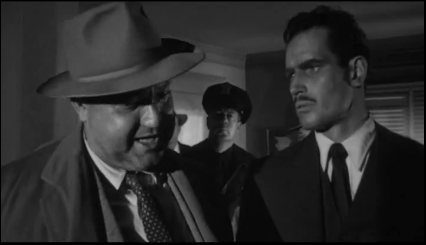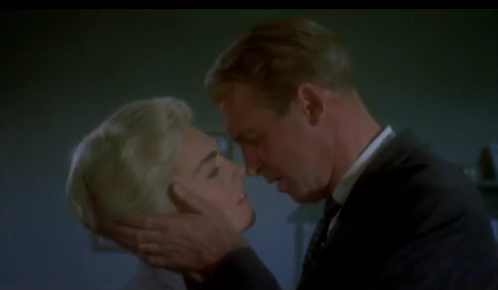
TOUCH OF EVIL (1958, Welles)
Most people know about the beautiful master shot at the top of this film, but Welles always spoke of another long oner in this film that he was more proud of. It’s the apartment interrogation scene from this stylish noir – a B picture elevated to classic status by the artistry of Orson Welles. (Funny, not only was this guy one of my dad’s heroes, but he is the spitting image of my mid-life dad here. A case of life imitating art combined with too many hamburgers.)
During post production, this film was famously butchered by Universal; Welles was deservedly on the outs for his decadent and mercurial ways (no pun intended). But thankfully the film was restored to Welles’ vision in 1998 by Walter Murch, using 58 pages of editing notes that Welles had left behind. (You can read the thing here, thanks to Wellesnet.com: WELLES TOUCH OF EVIL MEMO – If you do nothing else, watch the opening 20 minutes of both versions and you’ll see a phenomenal case study on not only the brilliance of Welles, but also the power of intercutting two parallel stories, a design that Universal had refused to stick to when the film was released. Restoring it to Welles’ intent is an improvement that’s hard to overstate.)
Back to today’s shot – Welles was excellent at blocking these long master shots. He could create organic blocking for actors, each move beautifully motivated, keep the camera in the most interesting places, and deliver an amazingly nuanced performance of his own. How fun would it have been to see what was going on behind the scenes as camera assistants ducked and tape marks littered the floor.
Hitchcock did an entire movie in one shot, but not nearly as dynamically, seamlessly, cinematically, or organically as what Welles pulls off here, if you ask me. Again, it’s about the to-and-from-camera blocking of the actors that gives Welles’ scene such nice depth as well as Welles’ characteristically low-camera makes for especially interesting compositions.
Orson Welles’ Touch of Noir
Allowing big parts of the action to happen off screen not only serves to simplify the blocking of the camera/actors, but increases the tension and dramatic impact of those off-camera moments. The whole thing has a building, claustrophobic feel just right for the action. Welles relishes the license that making a ‘noir’ gives him – hard light, shadows, distorting lenses, clipped and overlapping dialogue, and a wrinkled trench coat, to name a few touches (of evil).
Hope you’ll enjoy meeting or revisiting this classic scene.


Guyf
Pretty damn impressive.
jsbfilm
Totally. It’s like the oisuki shot in POABW.
Guyf
Ha! Not quite as impressive as that shot. I mean, you had to walk backwards and everything. And the timing was impeccable. I have no idea how you got that large, rusted, mufflerless truck to drive by at just the right moment. But we’ll leave that one for when you start a blog about sound editing. The isolation and crescendo there is classic!
torsloke
MAH! I don’t speak Mexican!
Pingback: THE CAT’S MEOW (2001, Bogdanovich) « shot4shot
Pingback: A Oner is Funner | shot4shot